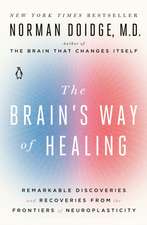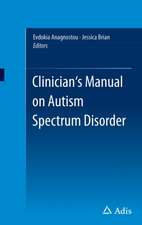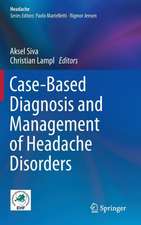Intracranial Pressure VIII: Proceedings of the 8th International Symposium on Intracranial Pressure, Held in Rotterdam, The Netherlands, June 16-20, 1991
Editat de C.J.J. Avezaat, J.H.M. van Eijndhoven, A.I.R. Maas, J.T.J. Tansen Limba Engleză Paperback – 15 dec 2011
Preț: 759.98 lei
Preț vechi: 799.97 lei
-5% Nou
Puncte Express: 1140
Preț estimativ în valută:
145.42€ • 152.22$ • 121.04£
145.42€ • 152.22$ • 121.04£
Carte tipărită la comandă
Livrare economică 31 martie-14 aprilie
Preluare comenzi: 021 569.72.76
Specificații
ISBN-13: 9783642777912
ISBN-10: 3642777910
Pagini: 972
Ilustrații: XXXIII, 931 p.
Dimensiuni: 170 x 242 x 51 mm
Greutate: 1.52 kg
Ediția:Softcover reprint of the original 1st ed. 1993
Editura: Springer Berlin, Heidelberg
Colecția Springer
Locul publicării:Berlin, Heidelberg, Germany
ISBN-10: 3642777910
Pagini: 972
Ilustrații: XXXIII, 931 p.
Dimensiuni: 170 x 242 x 51 mm
Greutate: 1.52 kg
Ediția:Softcover reprint of the original 1st ed. 1993
Editura: Springer Berlin, Heidelberg
Colecția Springer
Locul publicării:Berlin, Heidelberg, Germany
Public țintă
ResearchDescriere
The pioneering work by Pierre Janny and Nils Lundberg added a new tool to the investigative armamentarium of the neurosurgeon: continuous monitor ing of intracranial pressure (ICP). A small group of basic and clinical sci entists recognized the importance of this method and in 1972 an International Symposium was organized by Mario Brock in Hannover, Germany. The workers "of the first hour" had high expectations and thought that the problem of intracranial hypertension could finally be dealt with. The Symposium con tinued to grow during subsequent meetings in Lund (1974), Groningen (1976) and Williamsburg (1979). However, the advent of the modern imaging tech niques of CT and MRI have dramatically changed the scene in clinical neurology and neurosurgery. These new methods as well as other monitoring techniques have put ICP in its proper place as just one of the many aspects, albeit an important one, in the management of patients with intracranial space-occupying lesions. The symposia in Tokyo (1982), Glasgow (1985) and Ann Arbor (1988) confirmed the steady interest in ICP recording, both as a research tool and as a clinical method. and yielded many new developments in the field of ICP. This book comprises the proceedings of the Eighth International Symposium on Intracranial Pressure that was held in Rotterdam, The Netherlands, from June 16th to 20th, 1991.
Cuprins
Session I: Methodology and Mass Lesions.- Methodology.- Clinical Evaluation of the Camino Ventricular Bolt Pressure Monitoring System.- A Clinical Evaluation of an Intraparenchymal Intracranial Pressure Transducer.- Continuous Monitoring of Supratentorial Cerebral Tissue Pressure in Neurosurgical Routine. Experience with 125 Patients.- Continuous Monitoring of Cerebral Tissue Pressure After Elective Posterior Fossa Surgery.- A Fiberoptic Device Suitable for Subdural Pressure Measurement.- Anterior Fontanelle Pressure Monitoring in Infants.- Anterior Fontanelle Pressure Values in Normal Young Children of Various Ages.- A New Way to Monitor External Ventricular Drainage.- Post Traumatic Cerebrospinal Fluid Infections in the Traumatic Coma Data Bank: The Influence of the Type and Management of ICP Monitors.- Intracranial Distension in Neurosurgical Pathology.- Data Analysis.- On-Line Acquisition and Analysis of ICP and Physiologic Data in the Neurosurgical Intensive Care Unit.- Continuous Monitoring and Recording of Cerebral Perfusion Pressure.- Attempts to Continuously Monitor Autoregulation and Compensatory Reserve in Severe Head Injuries.- Further Attempts to Anticipate Post-traumatic Intracranial Hypertension by On-line Analysis.- Mass Lesions.- The Mechanism of Formation of Brain Tumor Cysts.- Spontaneous Putaminal Haematoma. Does Post-Operative ICU Management Improve Outcome?.- Assessment of Brainstem Distortion Associated with Extraaxial Supratentorial Mass by Magnetic Resonance Imaging.- Bilateral Intraparenchymal Pressure in Patients with Unilateral Supratentorial Mass Lesions.- Effects of Glycerol on Cerebral Blood Flow and Neural Function in Patients with Intracranial Space Occupying Lesions.- Peritumoral Edema and Regional Cerebral Blood Flow in Brain Tumors.- Session II: Experimental Aspects.- Edema.- Compression-induced Brain Edema: Regional Changes of Superoxide Free Radicals in the Development of Vasogenic Edema and Tissue Damage in Intracranial Hypertension.- The Effect of Lazaroid on Cerebral Elastance and Edema in a Cryogenic Injury Model.- Effects of Corticosteroid and Mannitol on the Early and Developed Stage of Vasogenic Brain Edema Evaluated by Proton Relaxation Behaviour.- The Effect of Hypoxia, Hypercapnia, and Hypertension on Brain Edema.- Role of Stimulation of Medullary Reticular Formation on Centrally Released Arginine Vasopressin in Cold Induced Edema.- Amino-Acids Release in Cerebrospinal Fluid After Injury of Cat Brain with Cold Lesion.- Regional Tissue Compliance of Edematous Brain After Cryogenic Injury in Cats.- Microautoradiographic Examination of Edema Fluid Distribution in the Cat Brain After Cryogenic Injury.- Gray Matter Edema Following Subarachnoid Hemorrhage.- Blood-Brain Barrier.- Effects of Leukotriene C4 and Acivicin on the Blood-Brain Barrier Permeability of Ischemic Rat Brains: Proof of Existence of Enzymatic Barrier.- Temporary Blood Brain Barrier Damage and Continued Edema Formation in Experimental Closed Head Injury in the Rat.- Breakdown of the Blood-Brain Barrier to Horseradish Peroxidase After Experimental Post-Traumatic Hypoxic Brain Injury.- Delayed Opening of the Blood-Brain Barrier in Direct Infusion Edema Model.- Effect of Osmotic Opening of Blood-Brain Barrier on the Learning of Rats.- Ischemia.- Improved Recovery with 21-Aminosteroid (U74006F) Pretreatment After Incomplete Cerebral Ischemia.- Effects of Respiratory Depression on Cytoprotective Effect of the Competitive NMDA Antagonist, D-CPPene.- Electrical Impedance, ICP and Histology in Rats with Sagittal Sinus Occlusion.- Experimental Study on Cerebral Venous Circulatory Disturbance.- Measuring the Degree of Ischemic Change by AVDO2 and EEG.- Local Cerebral Blood Flow, Glucose Content and Glucose Utilization in Focal Cerebral Ischemia in Spontaneously Hypertensive Stroke-Prone Rats.- Effect of External Decompression on Cerebral Venous System Occlusion.- Epidural Pressure and Cerebral Perfusion Pressure in Cerebral Infarction with Massive Brain Swelling.- Effects of Prostacyclin Analog (OP-2507) on Experimental Focal Cerebral Ischemia.- Hyperthermia.- Intracranial Pressures and Fever in the Rat, Rabbit and Cat.- Influences of Total Body Hyperthermia by Extracorporeal Circulation on Intracranial Hemodynamics in Dogs.- Neurophysiology.- Control of ICP by the Medullary Reticular Formation.- Analysis of Pyramidal Tract Function in Experimental Intracranial Hypertension by Magnetic Stimulation.- Neurophysiological Evidence of Preservation of Brain Stem Function in Experimental Closed Head Injury in the Rat.- Panel 1: Methodology and Experimental Aspects.- Session III: Cerebrovascular Dynamics I.- Cerebral Blood Flow and Metabolism: Experimental.- Effect of Increased ICP and Decreased Cerebral Perfusion Pressure on Brain Tissue and Cerebrospinal Fluid Oxygen Tension.- The Effect of Hypoxia on Intracranial Pressure and Cerebral Blood Flow.- Intracranial Hypotension: A Feline Model and Effects on Cerebral Blood Flow.- Change of Cerebral Electrophysiological Activity, Regional Cerebral Blood Flow and Regional Cerebral Blood Volume in Acute Intracranial Hypertension.- Local Cerebral Blood Flow Mapping Before and After Removal of Acute Subdural Hematoma in the Rat.- The Effects of NMDA Antagonists on Intracranial Pressure In a Model of Acute Subdural Haematoma in the Rat.- Intracranial Pressure and Phosphorus-31 Magnetic Resonance Spectroscopy in Cats.- Biomechanical Regulation of Cerebral Blood Flow.- Cerebral Blood Flow Restoration After Decompressive Craniectomy in Cold Induced Brain Edema.- The Metabolic Protection of Hypoxia by Etomidate Evaluated by Magnetic Resonance Spectroscopy.- Effect of Torasemide — A New Cl--Transport Inhibitor on Glial Swelling by Lactacidosis and Glutamate.- The Effects of Vasopressin on Intracranial Pressure and Cerebrovascular Dynamics in the Rat.- Cerebral Blood Flow and Metabolism: Clinical.- Cerebral Aerobic Index and Oxygen/Glucose Ratio in Acute Brain Injury.- Combined Monitoring of ICP and Cerebrovenous Oxygen Saturation to Estimate Cerebral Blood Flow.- Functional Exploration of the Internal Jugular Veins.- Blood Pressure and ICP Dynamics in Severe Head Injury: Relation with CBF Autoregulation.- Reversibility of Cerebral Circulatory Arrest (CCA) Following Severe Intracranial Hypertension.- ICP and Flow Dynamics After Subarachnoid Hemorrhage.- Session IV: Cerebrovascular Dynamics II.- Transcranial Doppler.- Evaluation of Closed Head Injury Patients Using Transcranial Doppler Monitoring.- The Significance of Increased Transcranial Doppler Flow Velocity After Severe Brain Injury.- A Study of Alterations of Cerebral Circulation Following Head Injury Using Transcranial Doppler Sonography.- Impaired Carbon Dioxide Reactivity Predicts Poor Outcome In Severe Head Injury: A Transcranial Doppler Study.- Cerebrovascular Reactivity Assessed by Changes in ICP and Transcranial Doppler.- Relationship Between Cerebral Perfusion Pressure and Pulsatility Index of Transcranial Doppler Sonogram.- Estimation of Cerebral Perfusion Pressure From Transcranial Doppler Sonography in Comatose Patients.- Changes in Cerebral Blood Flow During ICP Monitoring.- Non-Invasive Monitoring of Intracranial Pressure Gradients by Means of Transcranial Doppler.- Wave Form Analysis.- Comparison of Methods for ICP Waveform Analysis with Intracranial Hypertension in Head-Injured Patients.- Effects of Heart Rate on the Shape of the Intracranial Pressure Wave and Related Parameters.- Vascular Mapping of the Intracranial Pulse Wave.- Changes of Intracranial Pressure and Pulse Wave Form Induced by Various Mechanical Stresses Upon Intracranial Hemodynamics.- Analysis of the Intracranial Pressure Waveform by Means of Spectral Methods.- Continuous Analysis of the Intracranial Pressure Waveform as a Method of Autoregulatory Reserve Assessment.- Differential Effect of Hypercarbia and Hypertension on Cerebrovascular Pressure Transmission and Craniospinal Compliance.- A Simulation Study of Wave Transformation Using a Nonlinear Model of Artery and a Physical Model of Intracranial Vascular Bed.- Computer Analysis of Intracranial Pressure Pulsatility and Blood Flow Shape During Intracranial Hypertension.- Influence of Intracranial Components on Epidural Pulse Pressure.- Systolic Cerebral Blood Inflow (SCBI) as a CBF-Index Estimated with ICP Wave — Change in CBF and SCBI During Mannitol Infusion.- Dynamic Response of Subdural Screw Bolt for Intracranial Pressure Measuring.- Analysis of Periodic Waveforms of Brain Element Oscillations.- Pressure Waves.- Cyclic CSF Pressure Waves Causally Relate to Systemic Arterial Blood Pressure.- Changes in Jugular Bulb Oxygen Saturation and Associated Changes in Intracranial Pressure.- Spontaneous Fluctuations in Cerebral Blood Flow as a Cause of B Waves.- Postural Changes.- Changes in Cerebral Hemodynamics With Head Elevation In Head-Injured Patients.- Effects of Postural Changes On Epidural Pressure and Cerebral Perfusion Pressure in Patients With Serious Intracranial Lesions.- Positive End-Expiratory Pressure in Supine and Sitting Positions: Its Effects on Intrathoracic and Intracranial Pressures.- Panel 2: Cerebrovascular Dynamics.- Bayer Round-Table Discussion on Methodology of Head Injury Trials.- Initial Assessment, Interim Monitoring and Final Outcome in Clinical Studies of Head Injury.- Lessons in Clinical Trial Design from the Traumatic Coma Data Bank.- Consequences for Trials of Variations in the Management of Severe Head Injuries.- Practical Problems During the Nimodipine Head Injury Trial II.- Session V: Head Injury.- Experimental.- Concussive Brain Injury Produces a State of Vulnerability for Intracranial Pressure Perturbation in the Absence of Morphological Damage.- Cerebral Blood Flow and Glucose Metabolism Following Experimental Head Injury.- Effect of Posttraumatic Hypoventilation.- The Role of LTC4 in the Development of Post-Traumatic Intracranial Hypertension.- Changes in Cerebrovascular Permeability and Excitatory Amino Acid-Mediated Cellular Swelling Following Experimental Concussive Brain Injury.- Lack of Relationship between Hippocampal Cell Loss and ICP After Experimental Head Injury.- Computerized Tomography and Magnetic Resonance Imaging.- CT Scan Predictors of Intracranial Hypertension After Head Injury.- Revaluation of Closed Head Injury: Comparative Study of MR and CT.- CT and MRI Evaluation of Traumatic Brain Edema and its Biochemical and Histological Correlates.- Post-Traumatic Ventricular Enlargement in the Traumatic Coma Data Bank: Incidence, Risk Factors, and Influence on Outcome.- ICP Monitoring.- Secondary Rise of Intracranial Pressure Following Severe Head Injury.- Characteristics of ICP of Head Injury in the Elderly.- Transporting and Monitoring the Head-Injured Patient.- Intracranial Pressure Monitoring in Multidisciplinary Care Unit.- Intracranial Pressure Related to Sleep.- Edema, Hemodynamics and Oxygenation.- The Contribution of Brain Edema to Brain Swelling.- Cerebral Blood Volume in Acute Head Injury: Relationship to CBF and ICP.- Intracranial Compliance and Cerebral Hemodynamics in Head-Injured Patients.- Cerebral Perfusion Pressure Management of Head Injury.- Intracranial and Cerebral Perfusion Pressure Monitoring in the Head Injured Patient: Which Index?.- Relationship between Cerebral Oxygenation and Perfusion Pressure in Acute Brain Injury.- Multimodality Monitoring of Intracranial Pressure Therapy After Severe Brain Injury.- CPP and SJO2 with ICP Reduction Therapy after Severe Head Injury.- Diffuse Axonal Injury.- ICP Monitoring of Severe Diffuse Axonal Injury.- Diffuse Traumatic Axonal Injury: A Longitudinal Study.- “Pure” Diffuse Axonal Injuries with Multiple Lesions on CT-Scan: Analysis of 20 Consecutive Patients.- Diffuse Axonal Injury: Changes of Cerebral Blood Flow, Intracranial Pressure and Evoked Potentials.- Session VI: Control of ICP.- Hyperventilation.- Ischemic Insult Due to Manual Ventilation in Head Injured Patients with Intracranial Hypertension.- Is There a Risk to Induce Ischemia by Hyperventilation Therapy?.- Osmotic and Other Agents.- Effects of Mannitol Treatment on Cerebral Water Content.- Pharmacokinetic Analysis of Mannitol in Relation to the Decrease of ICP.- The Early Role of Mannitol-Induced Hemodynamic Changes in the Control of Intracranial Hypertension.- A Comparison Study Between Mannitol and Glycerol Therapy in Reducing Intracranial Pressure.- A Pilot Study on Postoperative ICP Control by Glycerin Combined with Lidocaine or Nitroglycerin.- Effect of Hypertonic-Hyperoncotic Solutions (HHS) on Increased Intracranial Pressure after a Focal Brain Lesion and Inflation of an Epidural Balloon.- A Prospective Randomized Clinical Trial of Tromethamine (THAM) and its Effect Upon Outcome in Severe Head Injury.- Correction of CSF Acidosis and Craniospinal System Viscoelastic Parameters with Intrathecal THAM.- Comparison of Thiopentone and Propofol at Two Rates of Intravenous Administration in Severely Head Injured Patients.- Propofol Vs Thiopental for the Control of Elevated ICP in Head Injured Patients.- Hypotensive Agents.- Comparison of Sodium Nitroprusside and Labetalol on the Intracranial Pressure of Cats.- Cerebral Hemodynamic Response of Sodium Nitroprusside and Esmolol.- ICP and Systemic Blood Pressure Changes After Administration of Prostaglandin E1 in Acute Stage of SAH.- Anesthetic Agents.- Influence of Isoflurane on Cerebrospinal Fluid Pressure and Cerebral Blood Flow Velocity.- Isoflurane Vs. Nitrous Oxide: Impact on Cerebrospinal Fluid Pressure in Anesthetized Patients with Brain Tumors.- Influence of Anesthetic Agents on the Regional Cerebral Blood Flow in Rabbits with a Focal Cerebral Lesion and General Hypoxia.- Brain Blood Volume and Cerebral Hemodynamics in the Anesthetized Rat.- Flumazenil and ICP Changes during Reversal of Benezodiazepine Sedation.- Effect of Propofol on Cerebro-Spinal Fluid Pressure in Patients with and without Intracranial Hypertension.- Intracranial Pressure, Pressure-Volume Index and Cerebral Perfusion Pressure During Anaesthesia with Propofol in Neurosurgery.- Succinylcholine, Motor Deficits, Intracranial Hypertension and Potassium Levels in Brain Tumour Patients.- Miscellaneous.- Surgical Decision-Making in Patients with Traumatic Contusion and Intracerebral Haematoma — ICP Monitoring or CT Scanning?.- Spontaneously Disappearing Acute Subdural Hematomas: Conservative Treatment with Intracranial Pressure Monitoring.- How to Reduce the Ischemic Brain Damage Secondary to Severe Head Injury?.- Toxic Effects of Nutritional Support in the Severely Head Injured Patient.- Panel 3: Head Injury and Control of ICP.- Session VII: CSF Dynamics.- Models.- The Dynamics of Cerebral Blood Flow, Perfusion Pressure and CSF Circulation — A Modelling Study.- Interfering Factors in Cerebrospinal Parameter Estimation.- Elevated Venous Outflow Pressure in Head Injured Patients.- A Finite Element Analysis of Intracerebral Stress Distribution with Viscoelastic Model.- Experimentally Derived Law Governing the Time Relationship of a Pressure-Volume Adjustment in the Human Craniospinal System — A Diagnostic and Management Tool.- Dynamics and Statics of the Cerebrospinal Fluid: The Classical and a New Hypothesis.- Hydrostatic Force in Regulation of CSF Volume.- Osmotic Force of the CSF and Intracranial Pressure in Health and Disease.- CSF Outflow Resistance and Volume-Pressure Relationship.- CSF Dynamics and Cerebral Hemodynamics in ATP-Induced Hypotension.- Computerized Infusion Test Compared to Conventional Lumbo-Ventricular Perfusion for Measurement of Resistance to CSF-Outflow.- Comparison of Lumbar and Ventricular Constant Flow and Bolus Infusions in Hydrocephalus.- Normal CSF Dynamics in Man. Estimation of Pressure-Volume Index and Resistance to Outflow of CSF in Adults Without Intracranial Pathology.- Intracranial Pressure and Cerebrospinal Fluid Dynamics in the Adult Chronic Hydrocephalus Syndrome.- Plateau Waves and Cerebrospinal Fluid Circulation.- Heart Rate Variability During Infusion Tests.- Identification of the Cerebrospinal Compensatory Mechanisms via Computer Controlled Drainage of Cerebrospinal Fluid.- The Pressure-Volume Index (PVI) with Epidural Mass Expansion.- Relationship Between Pressure-Volume Index and AMP/ICP When the PaCO2 is Changed.- Magnetic Resonance Imaging.- Bulk Flow and To-and-Fro Flow of CSF Observed on MRI and CT Cisternography.- CSF Flow Analysis Using Cine MRI in Patients with Hydrocephalic States.- Quantitative Analysis of CSF Pulsatile Flow in the Aqueduct with Dynamic MRI and Presaturation Bolus Tracking: The Flow Patterns and Clinical Aspects in Adults with Communicating Hydrocephalus.- Aqueductal CSF Flow on MRI and its Relation to Intracranial Pressure Dynamics.- Brain Edema Induced by Ventricular Puncture. A Study by Magnetic Resonance Imaging.- Session VIII: Hydrocephalus.- Normal Pressure Hydrocephalus.- Hydrocephalus-Analysis of 480 Infusion Tests.- Evaluation of Pressure Monitoring and CSF Conductance in NPH.- The Relative Prognostic Value of CSF Outflow Resistance Measurement in Shunting for Normal Pressure Hydrocephalus.- A Ventricular Infusion Technique for the Evaluation of Treated and Untreated Hydrocephalus.- Quantitative Analysis of Different Curves of Lumbar Repetitive Bolus Infusion Test in Patients with Ventriculomegaly.- Post-Shunting Improvement in Hydrocephalic Patients Described by Cerebrospinal Compensatory Parameters.- Diagnostic and Predictive Value of Axial and Coronal Spect with Technetium-99m Labelled D,L-Hexamethyl-Propylene Amine Oxime (99mTC HM-PAO) in Patients with Normal Pressure Hydrocephalus Syndrome (NPH).- Hydrocephalus Following Subarachnoid Haemorrhage.- Hydrocephalus Following Aneurysmal Subarachnoid Haemorrhage and Requiring Permanent Shunt.- Idiopathic Vs. Post-SAH Normal Pressure Hydrocephalus.- Dynamics of Hydrocephalus Development After Spontaneous Subarachnoid Hemorrhage.- Management Problems in Acute Hydrocephalus After Subarachnoid Hemorrhage.- Infantile Hydrocephalus.- Continuous Intraventricular Pressure and Simultaneous Cerebral Blood Flow Velocity (CBFV) Measurements During Sleep In Hydrocephalic Children.- A Volume-Blood Flow Velocity (VFR) Relationship Derived From CSF Compartment Challenge as an Index of Progression of Infantile Hydrocephalus.- Non-Invasive ICP-Monitoring in Childhood Hydrocephalus: A Comparison Between Anterior Fontanelle Pressure and Transcranial Doppler.- ICP and TCD Guided Treatment of Slit Ventricle Syndrome.- Cerebrospinal Compensation in Hydrocephalic Children.- Surgical Vs. Non Surgical Treatment of Neonatal Intra-Ventricular Hemorrhage.- CSF Shunts.- The Effect of Body Position on Cerebral Blood Flow in Normal Subjects and Subjects with Shunts.- Chronologic Changes in Intraventricular Pressure and Ventricular Size After Ventriculo-Peritoneal Shunt-Telemetric Measurement Using Osaka Telesensor (NS-20).- Changes of ICP After Shunt Surgery for Hydrocephalus — Long Time Evaluation by Telemetric Sensors.- Long Term in Vitro Test Results of Various New and Explanted Hydrocephalus Shunt Valves.- Flow-Regulating Devices Vs. Differential Pressure Valves In the Treatment of Triventricular Hydrocephalus.- Non-Invasive Quantification of CSF Flow in Shunts.- Application of Digital Subtraction Angiography for Quantitative Estimation of Shunt Function.- Non-Invasive Measurement of ICP in Shunt System by Collapse Technique.- Complications and Malfunctions of Derivative Surgery for Hydrocephalus.- Panel 4: CSF Dynamics and Hydrocephalus.










